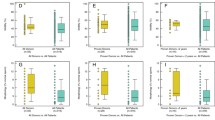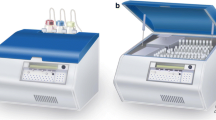Abstract
Purpose
High levels of reactive oxygen species (ROS) are a leading cause of male factor infertility. Measurement of ROS has been hampered by a lack of standardisation and confounding variables including choice of controls and sample selection. This study aimed to determine a reference range for ROS in human semen.
Methods
Semen samples were obtained from men attending for routine semen analysis who gave informed consent for the study. Samples were assigned groups: Group 1 (N = 94) normal semen parameters, no leucocytospermia; Group 2 (N = 100) abnormal semen parameters, no leucocytospermia; Group 3 (N = 41) any semen parameters with leucocytospermia. ROS levels were assayed in fresh neat semen using a chemiluminescence assay measured in a single tube luminometer. Data are reported in relative light units (RLU)/sec/106 sperm
Results
ROS levels were significantly different between Groups 1, 2 and 3 (19.75 ± 8.12, 95.03 ± 33.63, 890.17 ± 310.23 RLU/sec/106 sperm respectively; p < 0.001). Group 3 gave the highest value confirming this group as the optimum choice for positive controls. The reference range < 24.1 RLU/sec/106 sperm was determined by ROC analysis that differentiates a reference population (Group 1) from a positive control group (Group 3), optimising the sensitivity and specificity (80.5 and 87.2 % respectively) of the test.
Conclusions
We have determined a reference range for ROS in human semen and identified a patient population that falls outside the normal range. This simple, cost effective assay can be incorporated into routine diagnostic testing to aid in the diagnosis of male infertility, especially with regard to unexplained infertility.


Similar content being viewed by others
References
Irvine DS. Epidemiology and etiology of male infertility. Hum Reprod. 1998;13 Suppl 1:33–44.
McLachlan R, de Kretser D. Male infertility: the case for continued research. MJA. 2001;174:116–7.
WHO. WHO laboratory manual for the examination and processing of human semen. 5th ed. Cambridge: Cambridge University Press; 2010.
Moghissi KS, Wallach EE. Unexplained infertility. Fertil Steril. 1983;39:5–21.
Pizzol D, Ferlin A, Garolla A, Lenzi A, Bertoldo A, Foresta C. Genetic and molecular diagnostics of male infertility in the clinical practice. Front Biosci (Landmark Ed). 2014;19:291–303.
Agarwal A, Makker K, Sharma R. Clinical relevance of oxidative stress in male factor infertility: an update. Am J Reprod Immunol. 2008;59:2–11.
Tremellen K. Oxidative stress and male infertility – a clinical perspective. Hum Reprod Update. 2008;14:243–53.
Mahfouz RZ, Sharma R, Thiyagarajan A, Kale V, Gupta S, Sabanegh E, et al. Semen characteristics and sperm DNA fragmentation in infertile men with low and high levels of seminal reactive oxygen species. Fertil Steril. 2010;94:2141–6.
Henkel R. Leukocytes and oxidative stress: dilemma for sperm function and male fertility. Asian J Androl. 2011;13:43–52.
Aitken RJ, Smith TB, Jobling MS, Baker MA, de Iuliis GN. Oxidative stress and male reproductive health. Asian J Androl. 2014;16:31–8.
Alvarez JG, Touchstone JC, Blasco L, Storey BT. Spontaneous lipid peroxidation and production of hydrogen peroxide and superoxide in human spermatozoa. J Androl. 1987;8:338–48.
Plante M, de Lamirande E, Gagnon C. Reactive oxygen species released by activated neutrophils, but not by deficient spermatozoa, are sufficient to affect normal sperm motility. Fertil Steril. 1994;62:387–93.
De Lamirande E, Gagnon C. Impact of reactive oxygen species on spermatozoa: a balancing act between beneficial and detrimental effects. Hum Reprod. 1995;10:15–21.
Aitken RJ, Curry BJ. Redox regulation of human sperm function: from the physiological control of sperm capacitation to the etiology of infertility and DNA damage in the germ line. Antioxid Redox Signal. 2011;14:367–81.
Shi T-Y, Chen G, Huang X, Yuan Y, Wu X, Wu B, et al. Effects of reactive oxygen species from activated leucocytes on human sperm motility, viability and morphology. Andrologia. 2011;44:696–703.
Chen SJ, Allam JP, Duan YG, Haidi G. Influence of reactive oxygen species on human sperm functions and fertilizing capacity including therapeutical approaches. Arch Gynecol Obstet. 2013;288:191–9.
Morielli T, O’Flaherty C. Oxidative stress impairs function and increases redox protein modifications in human spermatozoa. Reproduction. 2015;149:113–23.
Ichikawa T, Oeda T, Ohmori H, Schill WB. Reactive oxygen species influence the acrosome reaction but not acrosin activity in human spermatozoa. Int J Androl. 1999;22:37–42.
Aitken RJ, Gordon E, Harkiss D, Twigg JP, Milne P, Jennings Z, et al. Relative impact of oxidative stress on the functional competence and genomic integrity of human spermatozoa. Biol Reprod. 1998;59:1037–46.
Zorn B, Vidmar G, Meden-Vrtovec H. Seminal reactive oxygen species as predictors of fertilization, embryo quality and pregnancy rates after conventional in vitro fertilization and intracytoplasmic sperm injection. Int J Androl. 2003;26:279–85.
Agarwal A, Allamaneni SS, Nallella KP, George AT, Mascha E. Correlation of reactive oxygen species levels with the fertilization rate after in vitro fertilization: a qualified meta-analysis. Fertil Steril. 2005;84:228–31.
Ghaleno LR, Valojerdi MR, Hassani F, Chehrazi M, Janzamin E. High level of intracellular sperm oxidative stress negatively influences embryo pronuclear formation after intracytoplasmic sperm injection treatment. Andrologia. 2014;46:1118–27.
Imam SN, Shamsi MV, Kumar K, Deka D, Dada R. Idiopathic recurrent pregnancy loss: role of paternal factors; a pilot study. J Reprod Infertil. 2011;12:267–76.
Aitken RJ, Baker MA. Oxidative stress, sperm survival and fertility control. Mol Cell Endocrinol. 2006;250:66–9.
Athayde KS, Cocuzza M, Agarwal A, Krajcir N, Lucon AM, Srough M, et al. Development of normal reference values for seminal reactive oxygen species and their correlation with leukocytes and semen parameters in a fertile population. J Androl. 2007;28:613–20.
Moein MR, Dehghani VO, Tabibnejad N, Vahidi S. Reactive oxygen species (ROS) level in seminal plasma of infertile men and healthy donors. Iran J Reprod Med. 2007;5:51–5.
Desai N, Sharma R, Makker K, Sabanegh E, Agarwal A. Physiologic and pathologic levels of reactive oxygen species in neat semen of infertile men. Fertil Steril. 2009;92:1626–31.
Guz J, Gackowski D, Foksinski M, Rozalski R, Zarakowska E, Siomek A, et al. Comparison of oxidative stress/DNA damage in semen and blood of fertile and infertile men. PLoS One. 2013;8:e68490.
Kullisaar T, Türk S, Kilk K, Ausmees K, Punab M, Mändar R. Increased levels of hydrogen peroxide and nitric oxide in male partners of infertile couples. Andrology. 2013;1:850–8.
Aitken RJ, Clarkson JS. Significance of reactive oxygen species and antioxidants in defining the efficacy of sperm preparation techniques. J Androl. 1988;9:367–76.
Agarwal A, Ikemoto I, Loughlin KR. Effect of sperm washing on levels of reactive oxygen species in semen. Arch Androl. 1994;33:157–62.
Shekarriz M, DeWire DM, Thomas Jr AJ, Agarwal A. A method of human semen centrifugation to minimise iatrogenic sperm injuries caused by reactive oxygen species. Eur Urol. 1995;28:31–5.
Venkatesh S, Shamsi MB, Dudeja S, Kumar R, Dada R. Reactive oxygen species measurement in neat and washed semen: comparative analysis and its significance in male infertility assessment. Arch Gynaecol Obstet. 2011;283:121–6.
Li Z, Zhou Y, Liu R, Lin H, Liu W, Xiao W, et al. Effects of semen processing on the generation of reactive oxygen species and mitochondrial membrane potential of human spermatozoa. Andrologia. 2012;44:157–63.
Allamaneni SSR, Agarwal A, Nallella KP, Sharma RK, Thomas Jr AJ, Sikka SC. Characterization of oxidative stress status by evaluation of reactive oxygen species levels in whole semen and isolated spermatozoa. Fertil Steril. 2005;83:800–3.
Fingerova H, Oborna I, Novotny J, Svobodova M, Brezinova J, Radova L. The measurement of reactive oxygen species in human neat semen and in suspended spermatozoa: a comparison. Reprod Biol Endocrinol. 2009;7:118–23.
Henkel R, Kierspel E, Stalf T, Mehnert C, Menkveld R, Tinneberg HR, et al. Effect of reactive oxygen species produced by spermatozoa and leukocytes on sperm functions in non- leukocytospermic patients. Fertil Steril. 2005;83:635–42.
Mupfiga C, Fisher D, Kruger T, Henkel R. The relationship between seminal leukocytes, oxidative status in the ejaculate, and apoptotic markers in human spermatozoa. Syst Biol Reprod Med. 2013;59:304–11.
Ochsendorf FR. Infections in the male genital tract and reactive oxygen species. Hum Reprod Update. 1999;5:399–420.
Sakamoto Y, Ishikawa T, Kondo Y, Yamaguchi K, Fujisawa M. The assessment of oxidative stress in infertile patients with varicocele. BJU Int. 2008;101:1547–52.
Kothari S, Thompson A, Agarwal A, du Plessis SS. Free radicals: their beneficial and detrimental effects on sperm function. Indian J Exp Biol. 2010;48:425–35.
Lavranos G, Balla M, Tzortzopoulou A, Syriou V, Angelopoulou R. Investigating ROS sources in male infertility: a common end for numerous pathways. Reprod Toxicol. 2012;34:298–307.
Kobayashi H, Gil-Guzman E, Mahran AM, Sharma RK, Nelson DR, Thomas Jr AJ, et al. Quality control of reactive oxygen species measurement by luminol-dependent chemiluminescence assay. J Androl. 2001;22:568–74.
Vessey W, Perez-Miranda A, Macfarquhar R, Agarwal A, Homa S. Reactive oxygen species (ROS) in human semen: validation and qualification of a chemiluminescence assay. Fertil Steril. 2014;102:1576–83.
Agarwal A, Allamaneni SS, Said TM. Chemiluminsecence technique for measuring reactive oxygen species. Reprod Biomed Online. 2004;9:466–8.
Saleh RA, Agarwal A. Oxidative stress and male infertility: from research bench to clinical practice. J Androl. 2002;23:737–52.
R Core Team. R: A language and environment for statistical computing. R Foundation for Statistical Computing, Vienna, Austria. 2013; URL http://www.R-project.org/.
Kashou AH, Sharma R, Agarwal A. Assessment of oxidative stress in sperm and semen. Methods Mol Biol. 2013;927:351–61.
WHO. WHO laboratory manual for the examination of human semen and sperm-cervical mucus interaction. 4th ed. Cambridge: Cambridge University Press; 1999.
Agarwal A, Sharma RK, Nallella KP, Thomas Jr AJ, Alvarez JG, Sikka SC. Reactive oxygen species as an independent marker of male factor infertility. Fertil Steril. 2006;86:878–85.
Desai NR, Mahfouz R, Sharma R, Gupta S, Agarwal A. Reactive oxygen species levels are independent of sperm concentration, motility and abstinence in a normal, healthy, proven fertile man: a longitudinal study. Fertil Steril. 2010;94:1541–3.
Pasqualotto FF, Sharma RK, Kobayashi H, Nelson DR, Thomas Jr AJ. Oxidative stress in normospermic men undergoing infertility evaluation. J Androl. 2001;22:316–22.
Aitken RJ, West K. Relationship between reactive oxygen species generation and leukocyte infiltration in fractions isolated from the human ejaculate on Percoll gradients. Int J Androl. 1990;13:433–51.
Deepinder F, Cocuzza M, Agarwal A. Should seminal oxidative stress measurement be offered routinely to men presenting for infertility evaluation? Endocr Pract. 2008;14:484–91.
Wright C, Milne S, Leeson H. Sperm DNA damage caused by oxidative stress: modifiable clinical, lifestyle and nutritional factors in male infertility. Reprod Biomed Online. 2014;28:684–703.
Showell MG, Brown J, Yazdani A, Stankiewicz MT, Hart RJ. Antioxidants for male subfertility. Cochrane Database Syst Rev. 2011;19(1), CD007411.
Gharagozloo P, Aitken RJ. The role of sperm oxidative stress in male infertility and the significance of oral antioxidant therapy. Hum Reprod. 2011;26:1628–40.
Vicari E. Effectiveness and limits of antimicrobial treatment on seminal leukocyte concentration and related reactive oxygen species production in patients with male accessory gland infection. Hum Reprod. 2000;15:2536–44.
Hamada A, Esteves SC, Agarwal A. Insight into oxidative stress in varococele-associated male infertility: part 2. Nat Rev Urol. 2013;10:26–37.
Ramya T, Misro MM, Sinha D, Nandan D. Sperm function and seminal oxidative stress as tools to identify sperm pathologies in infertile men. Fertil Steril. 2010;93:297–300.
Acknowledgments
The authors would like to thank Jeffrey Hammell for support with statistical analysis
Author information
Authors and Affiliations
Corresponding author
Additional information
Capsule A reference range for reactive oxygen species in human semen has been determined using a chemiluminescence assay measured in a single tube luminometer.
Rights and permissions
About this article
Cite this article
Homa, S.T., Vessey, W., Perez-Miranda, A. et al. Reactive Oxygen Species (ROS) in human semen: determination of a reference range. J Assist Reprod Genet 32, 757–764 (2015). https://doi.org/10.1007/s10815-015-0454-x
Received:
Accepted:
Published:
Issue Date:
DOI: https://doi.org/10.1007/s10815-015-0454-x




